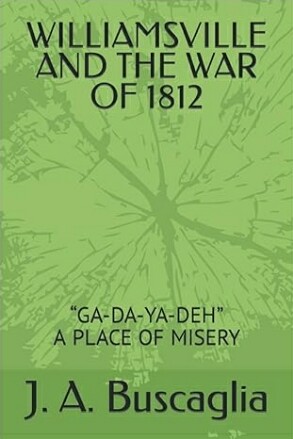
Possible Williamsville Cantonment Sites using reference
points from the war of 1812 accounts
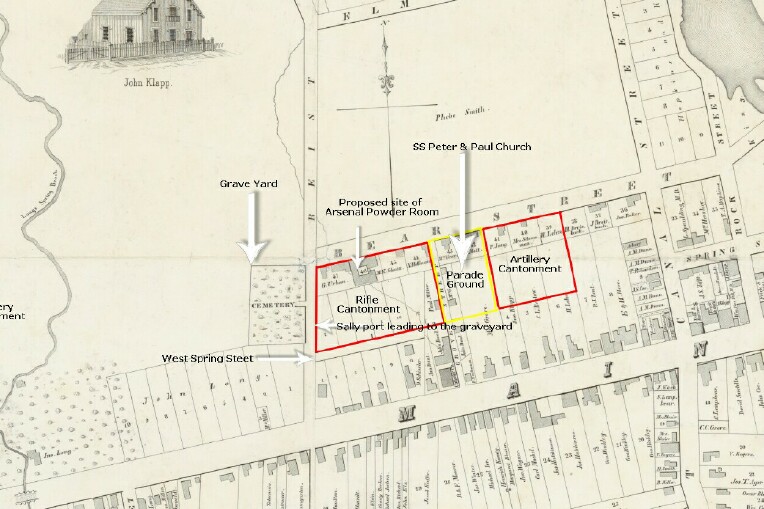
1854 Map of Williamsville, New York
First Account:
Source: Mordecai Myers, Reminiscences, 1780-1814, including
Incidents in the War of 1812 (Washington, 1900), 52.
Major Mordecai Myers of the Thirteenth Infantry related this harrowing occurrence
about sentry duty "I had in my company a young Irishman whose bravery
was never doubted; but while I commanded the cantonment at Williamsville
in the winter of 1812, a report was one morning current that O'Bryan had seen
the Devil when on post at the sally port leading to the graveyard.
Feeling that others might feel alarmed on going on the same post, I sent for
O'Bryan and said to him, 'It is said that you saw the Devil last night when
on post.' He turned very pale and said, 'I do not know whether it was the
Devil, but something black, about the size of a horse without a head came
rolling towards me. I challenged but received no answer; it was light, I plainly
saw it still approaching; I sighted my piece to fire, but lost my strength
and fell back against the cantonment where the relief soon after found me.
'I said, 'Are you afraid to go on the same post at the same hour tonight with
me? Perhaps we may find that there was no Devil, but your own fear of spirits.'
He said, 'Sir, I have never known fear, and I am willing to go with or without
you - but I should prefer to have you go with me / I went and we remained
on post two hours ;but the black Devil in the shape of a horse without a head
did not renew his visit, and my having been on post with O'Bryan was known
to all command, and it satisfied all that they might go on that post without
meeting 'His Satanic Majesty'."
The important part I believe is "O'Bryan had seen
the Devil when on post at the sally port leading to the graveyard."
There was only one known graveyard in Williamsville at the time the Long family
graveyard now the Williamsville Cemetery is one of the oldest cemeteries in
Erie County according to their website. This property was actually first used
for burials starting in February of 1810. But it wasn't until 1824 that the
land was formalized as a "Burying Ground" for local residents. So
by the winter of 1812 the graveyard was already 2 years old.
Second Account:
Source: Sue Miller Young, A History of the Town of Amherst, New York, 1818-1965
([Amherst, N.Y.]: Town Board of Amherst, 1965), 17
The barracks hospital was designated as a general military hospital in 1814,
and soon 1,100 sick and wounded were brought from Lewiston. By the spring
of that year, Williams Mills became an army base for more than 5,000 men assigned
to the Niagara Frontier. Briefly, the settlement was considered to be the
headquarters for the American forces during the war, with the arrivals of
General Brown and General Winfield Scott, who made temporary quarters in the
Evans house. During this time, soldiers were said to have been housed in log
barracks erected along Ellicott Creek, north and parallel of Main Street in
the vicinity of the present-day Garrison Road, which derives its name from
these military structures. Historian Sue Miller Young puts the location of
the arsenal and barracks on the north side of Main Street, between the site
of the present-day SS Peter and Paul Church and Glen Falls. Military drills
were held on the grounds near that church on Main Street.
Here Historian Sue Miller Young puts the location of the arsenal and barracks
on the north side of Main Street, between the site of the present-day SS Peter
and Paul Church and Glen Falls. Military drills were held on the grounds
near that church on Main Street.
Ok so the Arsenal and Barracks as well as the Parade Ground are on the North side of Main Street and the Parade Ground is where SS Peter and Paul Church is today.
Third Account:
From: Niles' Weekly Register Article from January 10, 1815.
Source
The troops will parade to-morrow morning at half past ten o'clock on the ground
between the rifle and artillery cantonments, to witness the execution of James
Campbell

Niles' Weekly Register Article from January 10, 1815
Ok so if the parade ground is between the Rifle and Artillery
Cantonments and the parade ground was located at where SS Peter and Paul Church
is today.We have a good idea where the Rifle and Artillery where located between
where SS Peter and Paul Church is today.
Fourth Account:
From A HISTORY OF BUFFALO AND NIAGARA FALLS
Source
As the spring of 1814 advanced more troops were placed on the frontier. Their presence here brought a considerable amount of money for distribution among the people of this section, and a ready market at high prices was the consequence. Williamsville was the principal rendezvous for the troops, and a long row of barracks was built parallel with Main street, and a little north of that thoroughfare, while other buildings used for hospital and other purposes connected with military affairs were situated about a mile up Eleven-mile creek. By April 1 thirty or forty houses were built under contract, and business was in a flourishing condition. On April 10 Brigadier-General Winfield Scott, a fine, soldierly officer of about thirty years of age, arrived at Buffalo, and his superior officer. General Brown arrived soon afterwards.
This account also states: a long row of barracks was built parallel
with Main Street, and a little north of that thoroughfare.
Conclusions
I believe that the area that is bounded by Reist Street on the West and Grove
Street to the East and Glen Ave on the North and West Spring Street to the
South is where the Rifle Cantonment and Arsenal was located the Parade Ground
was to the east of them and the Artillery Cantonment was to the east of the
Parade Ground. (See map below)
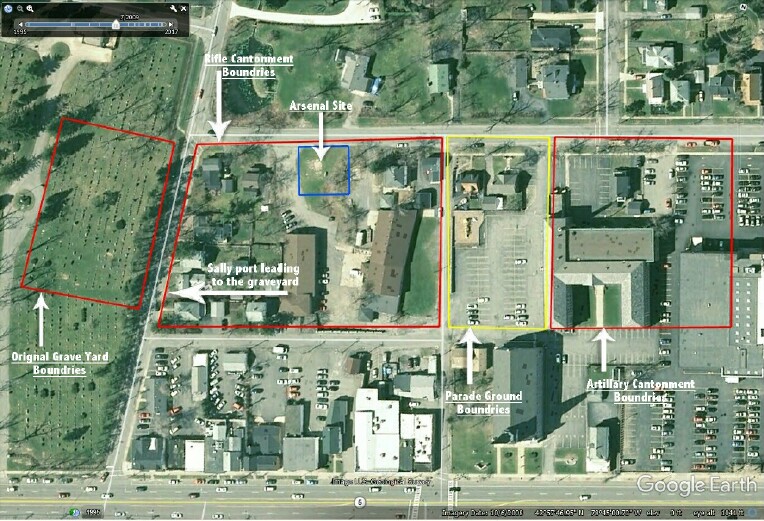
Present Day Google Earth Image of Area
This area also has a natural spring that could supply the Cantonment
with enough fresh drinking water the spring head was located near the corner
of present day West Spring Street and Grove street. There have been other
19th century ruins in the same area that I believe were part of the cantonment
see below.
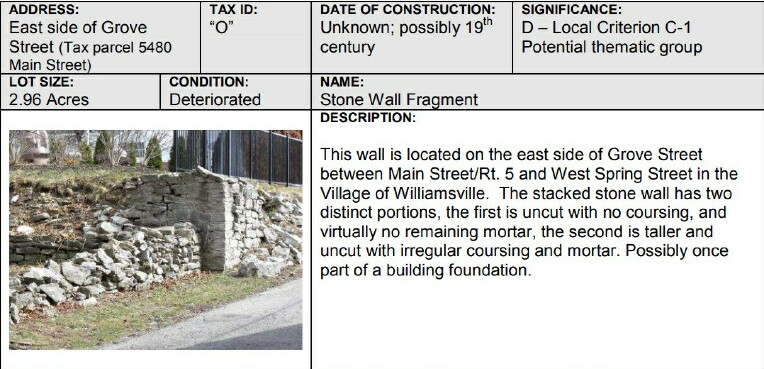
I also believe that the Arsenal powder room was located below the arsenal in a hidden basement on the backend of sub lot 46 of the 12th Township Range 7 Lot 1 the property is listed as 34 West Spring Street on the Town of Amherst Lot Map it is bounded by 87 and 109 Glen Ave.
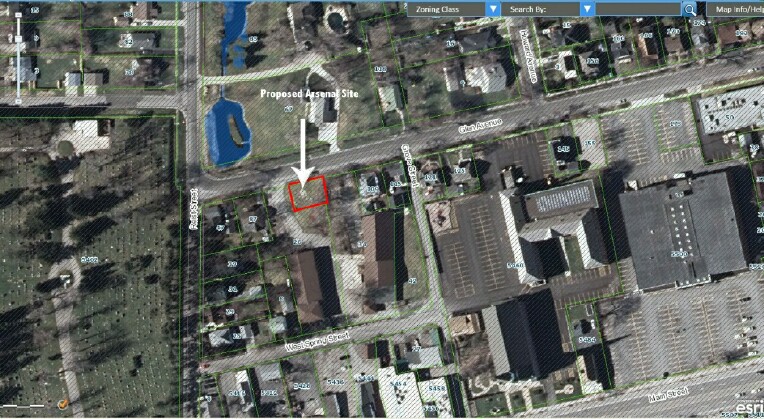
Town of Amherst Lot Map
While researching War of 1812 arsenals in New York I came across
this article about the Arsenal in Syracuse, NY and it had a hidden basement
as well. I believe that in this hidden basement the black powder was stored.
In an article By Dick Case, Post-Standard columnist Titled: Future uncertain
for ruins of stone arsenal built in Syracuse for War of 1812 Source

1880s photograph of the Onondaga Arsenal off East Seneca
Turnpike in Syracuse
States: This retired U.S. Navy veteran, and his son, Charlie, now a CBA high school senior, excavated the hidden basement of the aged leftover of what had been a three-story building, I believe that the Williamsville Arsenal also had a hidden basement and it is located off of Glen Ave right in between the lots at 87 & 109 Glen Ave. There are two big stone blocks covering a small opening into a manmade limestone chamber that I believe was the hidden basement of the Arsenal where the black powder was stored.
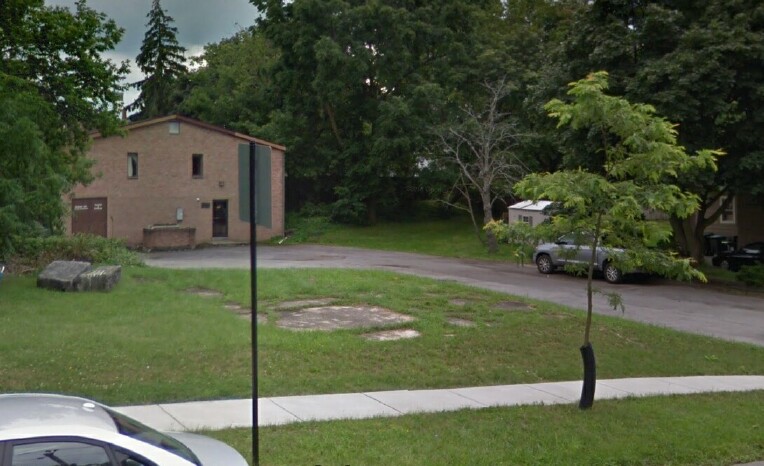
Photo of 87 Glen Ave. Location of Hidden Arsenal Basement
The two stone blocks on the left-hand side of the above photo show the location of the of the hidden Arsenal basement entrance. So if you take everything into account I believe this is the site of the Williamsville Rifle and Artillery Cantonments the Arsenal as well as the Parade Grounds.
First, you have the account of Major Mordecai Myers stating that there was
a Cantonment sally port that leads to the graveyard.
Second, the only graveyard at the time was the Long family graveyard established
in 1810 located today at the site of the Williamsville Cemetery which is bounded
by my proposed Cantonment location.
Third, there is a fresh water spring located at the corner of West Spring
Street and Grove Street this would be essential for that size of Cantonment.
Fourth, Historian Sue Miller Young puts the location of the arsenal and barracks
on the north side of Main Street, between the site of the present-day SS Peter
and Paul Church and Glen Falls. She also stated that Military drills were
held on the grounds near that church on Main Street. This also puts the Cantonment
in my proposed location.
Fifth, from the book A History of The City of Buffalo and Niagara Falls 1896
stated a long row of barracks was built parallel with Main street, and a little
north of that thoroughfare, while other buildings used for hospital and other
purposes connected with military affairs were situated about a mile up Eleven-mile
creek. This also puts the Cantonment in my proposed location.
Sixth, the Niles' Weekly Register Article from January 10, 1815. This places
the parade ground in between the Rifle and Artillery Cantonments in Williamsville.
Knowing that the parade ground was located where present day Saint Peter and
Paul's church is located we can assume that the Rifle and Artillery Cantonments
flanked the church.
Seventh, the article By Dick Case, Post-Standard columnist Titled: Future
uncertain for ruins of stone arsenal built in Syracuse for War of 1812 about
the hidden basement at the Syracuse Arsenal.
